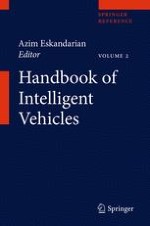2012 | OriginalPaper | Chapter
Fundamentals of Driver Assistance
Author : Prof. Azim Eskandarian, D.Sc.
Published in: Handbook of Intelligent Vehicles
Publisher: Springer London
Activate our intelligent search to find suitable subject content or patents.
Select sections of text to find matching patents with Artificial Intelligence. powered by
Select sections of text to find additional relevant content using AI-assisted search. powered by
